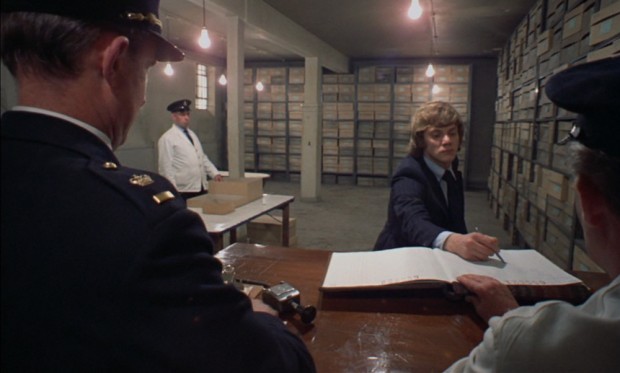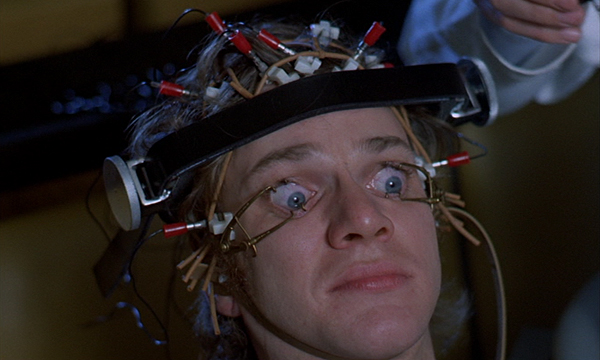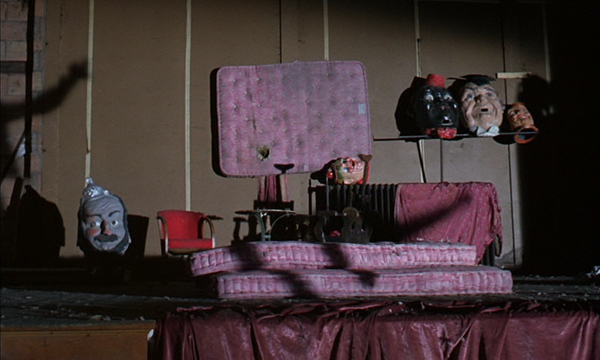REFLECTING ON 400 BLOWS AND

Go to Table of Contents of the analysis (which has also a statement on purpose and manner of analysis and a disclaimer as to caveat emptor and my knowing anything authoritatively, which I do not, but I do try to not know earnestly, with some discretion, and considerable thought).
A Possible Allusion to Truffaut's 400 Blows
in Kubrick's A Clockwork Orange
In the 1960s and 1970s Truffaut's 1959 400 Blows became wildly popular, as far as foreign films go, as the inspirational "portrait of a young artist" for aspiring filmmakers who found an empathetic connection with the struggling societal outcast of the fourteen-year-old Antoine and his love for cinema, the magnetic, transformative attraction of film resonating powerfully for them as well. If I remember correctly, it was one of the first foreign films discussed when I was studying cinema in college, and though I grew up in a cinema desert, I was already familiar with Truffaut's homage to cinema due a Black Cat book of the film that I picked up when I was seventeen.
Very occasionally, viewing an old film, I will be startled to feel as though I had just taken a bite out of a Kubrick movie, and then shortly thereafter the "why" will occur on screen.
Many years having passed since I last watched 400 Blows, with the Filmstruck service shutting down on November 29th 2018, and Criterion Channel's new service not beginning until the spring, for symbolic and sentimental purposes it seemed fitting, after a month long binge of films, for the last movie I watched on Filmstruck to be Truffaut's 400 Blows.
Though I've not studied Truffaut's films as I have the films of some other directors, I've seen a number of Truffaut's films, and have viewed 400 Blows at least four times. Never had I made an association with Kubrick--but then with this viewing, as I watched the young Antoine being packed up in the police wagon to be carted off to jail, though there as yet seemed no accounting for it, I began to be powerfully reminded of Alex from A Clockwork Orange, despite the fact they are two very different characters, for Alex is a ruthless, calculating criminal, and Antoine is obviously a child whose minor sins and misdemeanors, when one examines his reasoning and circumstances, are those of a child whose environment has been unstable.

Antoine is carried away from his past in the police wagon.
With Antoine, we have a clear and devastating communication of a loss of childhood, as he is being carried away from it in a police wagon, through the streets of Paris, but not a loss of innocence, which is a reason why the separation from the familiar, and his family, no matter how dysfunctional it was, the journey into a new and alien world of incarceration, is so painful. Alex, who is supposed to be a juvenile, but is played by an adult, does communicate a certain youthfulness but not like that of a fourteen-year-old, he's far older in Kubrick's film. He skips school, and rapes and pillages, whereas Antoine skips school and steals a typewriter when trying to make some money to live on when he has run away from home. Antoine is only attempting to survive. But in the book Alex was, at fifteen, though a destructive criminal, only a year older than Antoine, and as Antoine was driven away to prison, tears streaming, silent, down his face, though there were no images yet to connect with A Clockwork Orange, I recollected Alex's shock at his criminality having evolved to murder, and I felt the absolute and irretrievable severance of a new existence from the old. Despite Alex's hardness, his thirst for violence, and his manipulative cunning, Kubrick does communicate some of the same with Alex.

The processing of Antoine for incarceration.
Then, there came the scene of Antoine and his incarceration, he handing over the items in his pockets, and signing his name. I had forgotten about this part. And I saw in it the scene in which Alex does the same as he enters prison, which is not in Burgess' book, not like this. As with in Truffaut's film, Kubrick moves the camera to behind the head of the officer who takes Alex's possessions and handles the book in which he signs, so that we have a framing that is very similar to Truffaut's framing of Antoine when he hands over his few possessions and signs his name.
The processing of Alex for incarceration.
I considered there was probably no relationship between the two films and that this single strong, visual similarity was just due both films having to do with being processed for incarceration.
But then this scene followed closely thereafter in Truffaut's film. Antoine's mother visits the facility where he has been housed and complains about his devotion to the cinema. She says, "He prefers to hole up in a theater for hours, ruining his eyes."

"He prefers to hole up in a theater for hours, ruining his eyes."
Alex's eyes pinned open while watching movies during his Ludovico programming
Which made me think of how Alex's eyes are pinned open when he is being programmed in the theater with the Ludovico technique, and that perhaps it was indeed possible that, in A Clockwork Orange, Kubrick had planted the ghost of an association, however small, with the so very influential 400 Blows. Both films are not just about juvenile delinquents (Alex is charged as an adult when he kills the Cat Woman), they are also about the power of cinema. Truffaut's own youth fictionalized in Antoine, his film is about his love for cinema, and, by extension, the great impression cinema makes on its audience. Kubrick's movie is also about film, the relationship of theater and cinema to the audience, but it is also about the boundaries involved, between the stage and audience, and the dissolution of these insulating barriers, how for Alex what is viddied on the screen is more real than real life, and how cinema is used in his reprogramming. I'm not suggesting that Kubrick was in any way making a philosophical comment on Truffaut's films, only that he has, in these scenes of Alex, perhaps acknowledged the influential 400 Blows, which was itself influenced by Jean Vigo's 1933 Zero for Conduct, a movie that sympathetically portrays students rebelling against the strict restraints of a boarding school.
Tame as it was, due the anarchy of the children against their disciplinarians, Zero for Conduct was banned in France from 1933 to 1945. The French government also bristled against Kubrick's Paths of Glory and managed to keep it from being shown in France until 1975, nearly 20 years after its release.
"in one sense Zero de Conduite represents something more rare than L'Atalante because the masterpieces consecrated to childhood in literature or cinema can be counted on the fingers of one hand. They move us doubly since the esthetic emotion is compounded by a biographical, personal and intimate emotion..."
Francois Truffaut
Vigo's Zero for Conduct also inspired Lindsey Anderson's 1968 film IF.....
"Seeing Vigo's film gave us the idea and also the confidence to proceed with the kind of scene-structure that we devised for the first part of the film..."
Lindsay Anderson on Zero for Conduct
Which is the clincher for me, that Kubrick has intentionally made reference to 400 Blows, for not only was Truffaut inspired by Vigo's Zero for Conduct, Lindsay Anderson has also acknowledged Vigo's influence on the film IF...., about a rebellion of boarding school students, and it was IF.... that, for all intents and purposes, due his turn as Mick Travis, won McDowell the role as Alex in A Clockwork Orange.
We may even find a direct reference to Vigo's Zero for Conduct in Kubrick's staging of the fight scene at the old casino.
The big heads on the casino stage.
The great rebellion in Vigo's film occurs during the school's commemoration day events, during which we have a surreal juxtaposition of authority figures seated inexplicably, unaccountably before a row of grotesque dummies. The boys who have escaped the school assail their masters and the dummies with projectiles before fleeing over the rooftops of Paris.

The dummies and authority figures against which the boys rebel.
We never do see Alex in school, which would have been too direct a parallel to these other films that otherwise have little to do with A Clockwork Orange, not to mention Malcolm McDowell's age would have begged some powerful suspension of disbelief. Instead, Alex's battle against authority is depicted entirely outside of the classroom, though we do have a schoolmaster or professor appear once, in the casino where Alex and his droogs almost come off as the good guys when they disrupt a rape and battle the Iron Cross bedecked Billy and his boys while grotesque big heads, mostly of authoritarian figures, look on. Kubrick used mannequins in Killer's Kiss, and uses female figures as furniture in A Clockwork Orange, so the appearance of the comical, grotesque heads in the casino appears as a natural progression out of Kubrick's general film vocabulary, but in the casino scene they are mostly authoritarian figures watching over the proceedings, including a man in a schoolmaster's cap, and a very prominently placed head, dressed in what seems to be a spiked kaiser helmet, that has an aspect similar to Kubrick's. He seems to have lampooned his authoritarian role as a director, just as he also does with Burgess, the author.
December 2018. Approx 1600 words or 4 single-spaced pages. A 12 minute read at 130 wpm.
Go to Table of Contents of the analysis (with supplemental posts)
Link to the main TOC page for all the analyses




